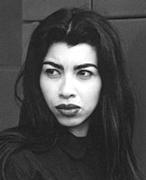|

| [ No Frames ] NAVIGATION: Home Page > Artist or Discography Index > Samia Farah biography | |||||||
|
|||||||
 |
| Samia Farah (Source: www.pirineos-sur.com) |
A profile of the Tunisian-French singer, whose many musical influences saw her to seek the services of Adrian Sherwood in search of a defining sound:
Samia Farah was born on August 2nd 1971 in Tunisia. As in other years, her father, bursar at the University Village of Paris, and her mother, a nurse, were spending their holidays back in Tunisia. The couple had been resident in France since the 1970s, but their families still lived in Tunisia and Samia often returned there.
At the age of 16, she decided to take a break from her studies to spend a few months back in Tunisia, as a temporary refuge for a teenager in search of an identity. There, among other things, she discovered reggae.
Her father had always been a music lover, listening freely and extravagantly to everything from jazz to European and Arab classics, albeit with a certain preference for the Egyptian crooner Muhammad Abdul Wahab, known as the supreme modernizer and the first artist to prove that Western and Eastern cultures are compatible. So Samia's ear travelled freely from one world to another. Back in France, Sarah Vaughan and Nina Simone caught Samia's attention and gave her an idea of what is meant by vocal style. Then came rap and ragga and she experimented with their broken phrasing in the female group Mama Benz.
 |
| The "Cool" single |
Gradually, she developed her own style somewhere between the velvet timbre of jazz singers and the staggered flow of hip-hop - a style that doesn't force you to yell, that lets you say stuff calmly. By stuff, she means her lyrics - enumerations of the inevitable bruises and ulcers that a sensitivity such as hers suffers in a world such as ours. She says that her words do not match her voice and her originality and charm spring from this contradiction. If we have a clear impression of uncertain hedonism in 'Cool' (the opening song on her self-titled first album and the subject of a single) this is due to her refined ability to blend the bitter and the sweet, vocally suggesting laziness, but using words to eliminate any hint of inanity or rapture.
As if freed of the weight of fashion and impervious to those attempts at intimidation that schools specialize in, Samia sings jazz, soul and reggae in her own way. Like the wax crayons she uses to draw and the papier-mâché she sculpts with, Samia subjugates matter and wills. When she contacted the cult producer Adrian Sherwood, he agreed to work with her on the album and accompanying singles. Laurent de Wilde, André Ceccarelli and other top names in jazz also lent a hand. At her request, Adrian Boot (Bob Marley's photographer) took the photos for the album, while she handled the graphic design herself.
 |
| The "Homesick Blues EP" |
Samia excels in her role as a thief of happiness: her singing is a caress and her tongue a spur. Gratingly sensual, cynically inflexible, fatalistically pugnacious, she finally allows us a glimpse of the talent that governs all her other gifts: femininity. Samia does not dare write about love because "...my words don't measure up to what I feel". Set to music with the help of Giovanny de la Hunda, her first album generally breaks with past forms in the albeit highly-crowded world of French song.
Samia subsequently recorded for Sherwood's On-U Sound itself with her 2004 'Homesick Blues EP' (ON-U CDS 1001) and in the process briefly became an On-U artist proper.
(Adapted from Samia's short biography found at worldmusiccentral.org/artists/artist_page.php?id=104)
| Back To Top |






